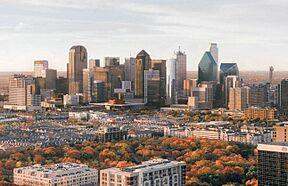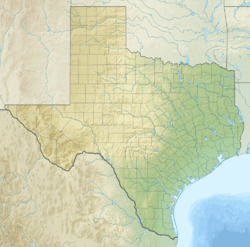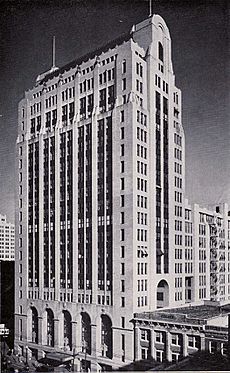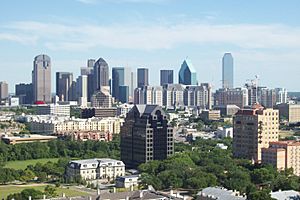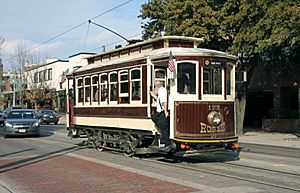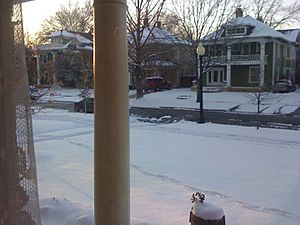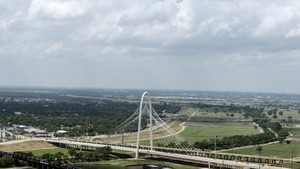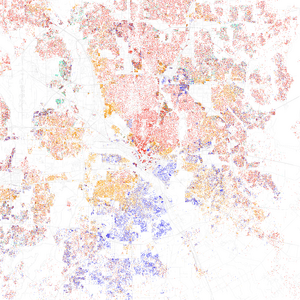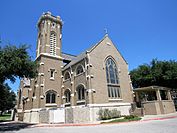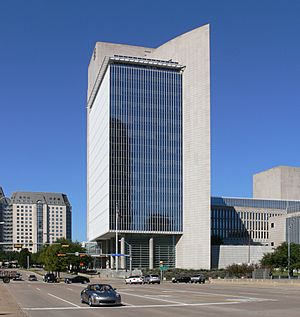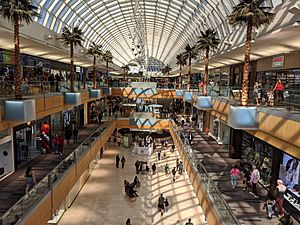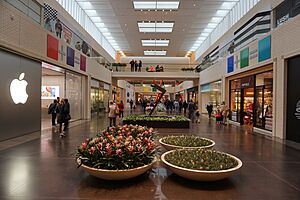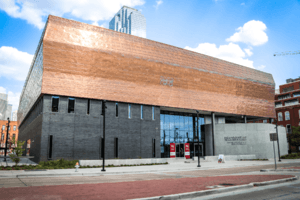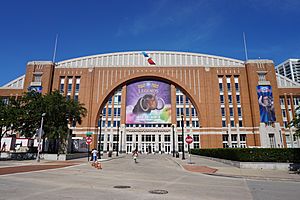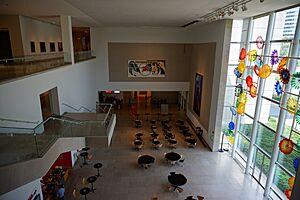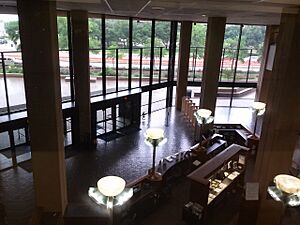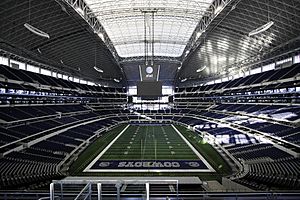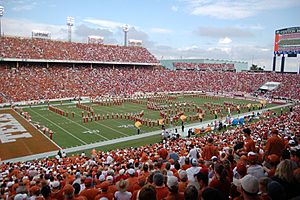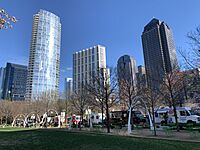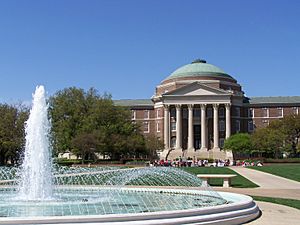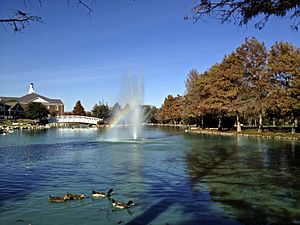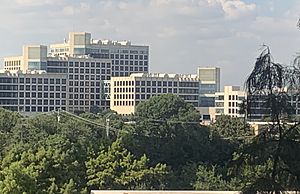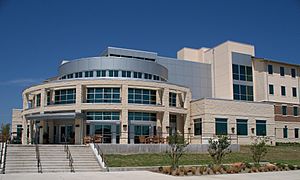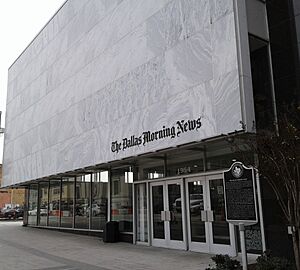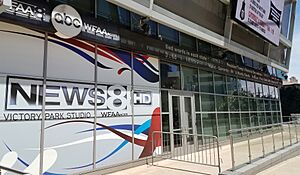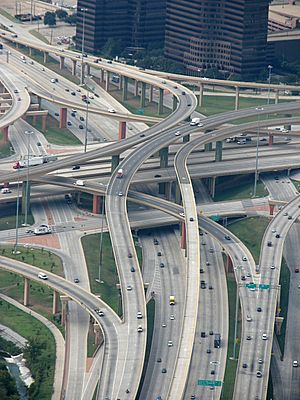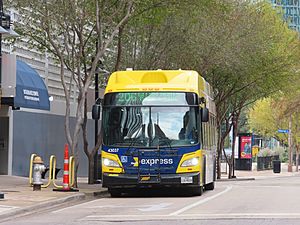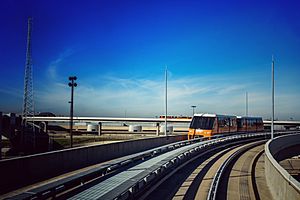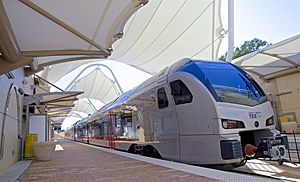Dallas facts for kids
Dallas is a big city in Texas, a state in the United States. It's the most populated city in the Dallas–Fort Worth metroplex, which is a huge area where many cities are close together. This metroplex is the fourth largest in the U.S. and the biggest in Texas! Dallas is also the ninth most populated city in the whole country and the third largest in Texas, after Houston and San Antonio.
Dallas is in North Texas and is a major hub for transportation and business. Long ago, Dallas and nearby Fort Worth grew because major railroad lines were built through the area. These railroads helped transport important goods like cotton, cattle, and later, oil. Today, Dallas is still a big transportation center with many major highways meeting here. It also has the Dallas Fort Worth International Airport, which is one of the biggest and busiest airports in the world. The city has a strong economy with many jobs in areas like financial services, information technology, and telecommunications. Many big companies have their main offices here. Dallas is also known for its diverse population, with people from many different backgrounds living here.
Quick facts for kids
Dallas
|
|||
|---|---|---|---|
|
City
|
|||
|
State Fair of Texas
Old Red Museum
Winspear Opera House
|
|||
|
|||
| Nicknames:
Big D, D-Town, Triple D, 214
|
|||
| Country | United States | ||
| State | Texas | ||
| Counties | Dallas, Collin, Denton, Kaufman, Rockwall | ||
| Incorporated | February 2, 1856 | ||
| Government | |||
| • Type | Council–manager | ||
| • Body | Dallas City Council | ||
| Area | |||
| • City | 385.9 sq mi (999.2 km2) | ||
| • Land | 339.604 sq mi (879.56 km2) | ||
| • Water | 43.87 sq mi (113.60 km2) | ||
| Elevation | 482 ft (147 m) | ||
| Population
(2020)
|
|||
| • City | 1,304,379 | ||
| • Rank | 21st in North America 9th in the United States 3rd in Texas |
||
| • Density | 3,840.88/sq mi (1,482.97/km2) | ||
| • Urban | 5,732,354 (US: 6th) | ||
| • Urban density | 3,281.5/sq mi (1,267.0/km2) | ||
| • Metro | 7,637,387 (US: 4th) | ||
| Demonym(s) | Dallasite | ||
| GDP | |||
| • Metro | 8.928 billion (2022) | ||
| Time zone | UTC−06:00 (Central) | ||
| • Summer (DST) | UTC−05:00 (Central) | ||
| ZIP Codes |
ZIP Codes
75201-75212, 75214-75238, 75240-75244, 75246-75254, 75260-75267, 75270, 75275, 75277, 75283-75285, 75287, 75301, 75303, 75312-75313, 75315, 75320, 75326, 75336, 75339, 75342, 75354-75360, 75367-75368, 75370-75374, 75376, 75378-75382, 75389-75395, 75397-75398
|
||
| Area codes | 214, 469, 945, 972 | ||
| FIPS code | 48-19000 | ||
| GNIS feature ID | 2410288 | ||
Contents
History of Dallas
Thousands of years ago, Native American groups lived in the Dallas area. The Caddo people were here before Spanish explorers claimed Texas in the 1700s. Later, France also claimed the land, but they didn't settle much.
In 1819, a treaty between the U.S. and Spain made the Red River the northern border of New Spain. This put the future Dallas area in Spanish territory. In 1821, Mexico became independent from Spain, and the area was part of Mexico. Then, in 1836, Texas became its own country.
Warren Angus Ferris explored the Dallas area in 1839. Then, in 1841, John Neely Bryan started a permanent settlement near the Trinity River. This settlement was named Dallas. Nobody is quite sure where the name came from! In 1845, Texas joined the United States. Dallas officially became a city on February 2, 1856.
As railroads were built, Dallas grew into a busy center for business and trade. By the late 1800s, it was booming! Dallas became an industrial city, attracting workers from all over. The Praetorian Building, built in 1909, was 15 stories tall. It was the first skyscraper west of the Mississippi River and showed how important Dallas was becoming.
In 1921, the Mexican president visited Dallas's Mexican Park in Little Mexico. This small neighborhood was home to many Hispanic people who came to Dallas. They were looking for better lives or escaping the Mexican Revolution.
John F. Kennedy Memorial
On November 22, 1963, President John F. Kennedy was in Dallas. His motorcade was passing through Dealey Plaza when he was shot. The building where the shots came from, the Texas School Book Depository, now has a museum. This museum, called the Sixth Floor Museum, tells the story of the former president's life.
Dallas Geography
Dallas is the main city of Dallas County. Parts of the city also reach into other nearby counties like Collin, Denton, Kaufman, and Rockwall. The city covers about 386 square miles (999 square kilometers). About one-fifth of all the land in the huge Dallas–Fort Worth metroplex is part of Dallas.
Amazing Architecture in Dallas
Dallas has many tall buildings, some over 700 feet high! While some buildings are from the late 1800s and early 1900s, most of the famous ones are from more modern times. You can see cool modern architecture like Reunion Tower and the JFK Memorial. Other buildings, like Fountain Place and Bank of America Plaza, show a style called postmodern architecture.
Some smaller buildings have a Gothic Revival look, like the Kirby Building. Others are in the neoclassical style, like the Davis and Wilson Buildings. If you visit Swiss Avenue, you'll see many historic houses. They show all kinds of styles, from Victorian to neoclassical. The Dallas Downtown Historic District protects many old commercial buildings from the 1880s to the 1940s.
Dallas Neighborhoods
Dallas is made up of many different neighborhoods, each with its own feel.
Central Dallas Areas
The heart of Dallas is Downtown. Nearby are Oak Lawn and Uptown. These areas are full of shops, restaurants, and places for nightlife. Downtown Dallas has special districts like the West End Historic District, the Arts District, and the Farmers Market District. Other popular spots include Victory Park, Dallas Design District, and Klyde Warren Park.
East Dallas Communities
East Dallas is home to Deep Ellum, a cool artsy area close to Downtown. You'll also find the cozy Lakewood neighborhood and historic areas like Vickery Place. Swiss Avenue and Munger Place have amazing homes. Some of these homes are in the Prairie-style, which is very special. In the northeast part of the city is Lake Highlands, a well-known middle-class neighborhood.
South Dallas Districts
South Dallas, located southeast of Downtown, includes the Cedars, which is a growing area for artists. It's also home to Fair Park, where the annual State Fair of Texas is held every fall.
Southwest of Downtown is Oak Cliff, a hilly area that has changed a lot recently. Neighborhoods like the Bishop Arts District are now very popular. Oak Cliff was once its own town before Dallas took it over in 1903. Today, many people of Hispanic background live in the northern part of Oak Cliff. The southern part has a mix of African American, Hispanic, and Native American residents.
South Side Dallas is now a popular place for fun at night. It has places like the NYLO rooftop patio and Gilley's, a famous country bar. This area has improved a lot and is now a great place to live and hang out.
Further east, Pleasant Grove is a large neighborhood. It used to be a separate city. This area is surrounded by undeveloped land. The wetlands here will become part of the Great Trinity Forest. This project aims to protect nature and help with flood control.
Dallas also has three smaller towns completely surrounded by its city limits: Cockrell Hill, Highland Park, and University Park.
Dallas Districts List
- Bishop Arts District
- Casa Linda
- Casa View
- Cedar Springs
- Cedars, The
- Deep Ellum
- Design District
- Downtown
- Exposition Park
- Fair Park
- Highland Hills
- Kessler Park
- Knox-Henderson
- Lakewood
- Lake Highlands
- Lower Greenville
- "M" Streets
- Oak Cliff
- Oak Lawn
- Park Cities
- Pleasant Grove
- Preston Hollow
- Trinity Groves
- Turtle Creek
- Uptown
- Victory Park
- West End
Dallas Land Features
Dallas and the area around it are mostly flat. The city sits at an elevation of about 450 to 550 feet (137 to 168 meters). A limestone cliff, called the "White Rock Escarpment," runs through Dallas County. It rises about 230 feet (70 meters) high. You can really see this cliff in neighborhoods like Oak Cliff and nearby cities.
Dallas was built along a river, like many old cities. The Trinity River is the main waterway through the city. It's not used for boats, but it's important for drainage. Levees, which are tall earthen walls, protect the city from floods.
Since the 1920s, the river has mostly been a drainage ditch near downtown. But now, there's a big plan called the Trinity River Project. This project aims to make the riverfront beautiful with new lakes, parks, and trails. It will create one of the largest urban parks in the world, covering about 10,000 acres (40 square kilometers).
White Rock Lake is another important water feature. It's a reservoir built in the early 1900s. People love to go boating, jogging, and biking here. The Dallas Arboretum and Botanical Garden is also on the lake's eastern shore. White Rock Creek flows into White Rock Lake and then into the Trinity River.
Bachman Lake, near Love Field Airport, is a smaller lake also used for fun. To the northeast is Lake Ray Hubbard, a huge reservoir. To the west is Mountain Creek Lake. There's also North Lake, which is being planned for recreation.
Dallas Climate and Weather
Dallas has a humid subtropical climate, which means it has hot, humid summers and mild winters. You can experience all four seasons here. January is usually the coldest month, with average lows around 37°F (3°C). Snowfall is not common but can happen.
Summers are hot and dry. July and August are the hottest months, with average highs around 96°F (36°C). Dallas is in "Tornado Alley", so it can have extreme weather like tornadoes and severe hailstorms.
Winters are generally mild, but temperatures can change quickly. Sometimes, strong cold fronts called "Blue Northers" bring colder air. Snow usually falls only one or two days a year. Sometimes, freezing rain or ice can make roads slick.
Spring and autumn are pleasant with mild weather. You'll see beautiful wildflowers like bluebonnets in the spring. Spring weather can be stormy, with thunderstorms, lightning, rain, hail, and sometimes tornadoes. Autumn also brings some storms, but usually fewer than in spring.
The air pollution in Dallas is higher than in some other U.S. cities. Much of it comes from industrial plants outside the city.
The lowest temperature ever recorded in Dallas was -3°F (-19°C) in 1930. The highest was 113°F (45°C) in 1980. Dallas gets about 37.6 inches (955 mm) of rain each year.
| Month | Jan | Feb | Mar | Apr | May | Jun | Jul | Aug | Sep | Oct | Nov | Dec | Year |
|---|---|---|---|---|---|---|---|---|---|---|---|---|---|
| Record high °F (°C) | 88 (31) |
95 (35) |
97 (36) |
100 (38) |
103 (39) |
112 (44) |
112 (44) |
111 (44) |
110 (43) |
100 (38) |
92 (33) |
89 (32) |
112 (44) |
| Mean maximum °F (°C) | 76.7 (24.8) |
80.5 (26.9) |
85.9 (29.9) |
89.0 (31.7) |
95.0 (35.0) |
98.9 (37.2) |
103.6 (39.8) |
104.1 (40.1) |
99.1 (37.3) |
92.5 (33.6) |
82.9 (28.3) |
77.9 (25.5) |
105.5 (40.8) |
| Mean daily maximum °F (°C) | 57.7 (14.3) |
62.0 (16.7) |
69.9 (21.1) |
77.4 (25.2) |
84.9 (29.4) |
92.7 (33.7) |
96.9 (36.1) |
97.1 (36.2) |
90.0 (32.2) |
79.5 (26.4) |
67.8 (19.9) |
59.2 (15.1) |
77.9 (25.5) |
| Mean daily minimum °F (°C) | 37.9 (3.3) |
41.9 (5.5) |
49.4 (9.7) |
56.8 (13.8) |
66.0 (18.9) |
73.8 (23.2) |
77.7 (25.4) |
77.4 (25.2) |
70.1 (21.2) |
58.7 (14.8) |
47.8 (8.8) |
39.8 (4.3) |
58.1 (14.5) |
| Mean minimum °F (°C) | 22.5 (−5.3) |
26.5 (−3.1) |
31.1 (−0.5) |
41.3 (5.2) |
52.0 (11.1) |
64.2 (17.9) |
70.8 (21.6) |
69.4 (20.8) |
56.8 (13.8) |
42.0 (5.6) |
31.2 (−0.4) |
25.1 (−3.8) |
19.1 (−7.2) |
| Record low °F (°C) | −3 (−19) |
2 (−17) |
11 (−12) |
30 (−1) |
39 (4) |
53 (12) |
56 (13) |
57 (14) |
36 (2) |
26 (−3) |
17 (−8) |
1 (−17) |
−3 (−19) |
| Average precipitation inches (mm) | 2.59 (66) |
2.78 (71) |
3.45 (88) |
3.15 (80) |
4.57 (116) |
3.83 (97) |
1.71 (43) |
2.19 (56) |
3.10 (79) |
4.79 (122) |
2.93 (74) |
3.23 (82) |
38.32 (973) |
| Average snowfall inches (cm) | 0.1 (0.25) |
0.9 (2.3) |
0.3 (0.76) |
0 (0) |
0 (0) |
0 (0) |
0 (0) |
0 (0) |
0 (0) |
0 (0) |
0.1 (0.25) |
0.3 (0.76) |
1.7 (4.3) |
| Average precipitation days (≥ 0.01 in) | 7.0 | 6.9 | 8.1 | 7.3 | 9.4 | 7.3 | 4.9 | 5.1 | 5.6 | 7.2 | 6.5 | 6.9 | 82.2 |
| Average snowy days (≥ 0.1 in) | 0.4 | 0.5 | 0.2 | 0 | 0 | 0 | 0 | 0 | 0 | 0 | 0.1 | 0.3 | 1.5 |
| Average relative humidity (%) | 67.5 | 66.4 | 63.7 | 65.3 | 69.7 | 65.8 | 59.8 | 59.5 | 66.5 | 65.7 | 67.4 | 67.5 | 65.4 |
| Average dew point °F (°C) | 31.3 (−0.4) |
35.2 (1.8) |
42.6 (5.9) |
52.0 (11.1) |
61.0 (16.1) |
66.6 (19.2) |
67.6 (19.8) |
66.7 (19.3) |
63.3 (17.4) |
53.2 (11.8) |
43.7 (6.5) |
34.7 (1.5) |
51.5 (10.8) |
| Mean monthly sunshine hours | 183.5 | 178.3 | 227.7 | 236.0 | 258.4 | 297.8 | 332.4 | 304.5 | 246.2 | 228.1 | 183.8 | 173.0 | 2,849.7 |
| Percent possible sunshine | 58 | 58 | 61 | 61 | 60 | 69 | 76 | 74 | 66 | 65 | 59 | 56 | 64 |
| Average ultraviolet index | 3 | 5 | 7 | 9 | 10 | 10 | 10 | 10 | 8 | 6 | 4 | 3 | 7 |
| Source 1: NOAA (sun, relative humidity, and dew point 1961–1990 at DFW Airport) | |||||||||||||
| Source 2: Weather Atlas (Average UV index) | |||||||||||||
Dallas Population and People
Dallas is the ninth most populated city in the United States and the third in Texas. The Dallas area is home to about one-quarter of all Texans! In 2020, the city of Dallas had 1,304,379 residents.
There were over 524,000 households in Dallas in 2020. About 26.5% of the people were under 18 years old, and 8.8% were 65 or older. The average age was 32.9 years.
The average income for a household in Dallas was about $54,747 in 2020. About 21.7% of the population lived below the poverty line. In 2022, there were about 4,410 homeless people in Dallas.
The Dallas area has mosquitoes, which can be a problem. The city regularly sprays to control them and prevent diseases like West Nile virus.
Dallas's Diverse Population
Dallas has become very diverse over time. In 1930, most people were white. Today, less than one-third of the city's population is non-Hispanic white. In 2019, about 41.2% of the population was of Hispanic or Latino background. Many people of Mexican American and other Latin American backgrounds live here. The southwest part of the city, especially Oak Cliff, has many Hispanic residents.
Dallas is also a major place for Black and African Americans. Many have moved here from other parts of the country. There are also many immigrants from places like Ethiopia, Eritrea, and Somalia.
The Dallas area has many Asian Americans, including people from India, Vietnam, China, Korea, and the Philippines. The northern suburbs like Plano and Richardson have large Asian communities. There are also many Russian-speakers and Iranian Americans in the area. Because of all these different groups, you'll often see signs in many languages around the city.
Religion in Dallas
| Religious affiliation (2014) | ||||
|---|---|---|---|---|
| Christian | 78% | |||
| Protestant | 59% | |||
| Catholic | 15% | |||
| Other Christian | 4% | |||
| Unaffiliated | 18% | |||
| Jewish | 1% | |||
| Muslim | 1% | |||
| Other faiths | 2% | |||
Christianity is the most common religion in Dallas. Many Protestant churches are found here, like Methodist, Baptist, and Presbyterian churches. Dallas is also home to two evangelical seminaries.
The Catholic Church is also very important in Dallas. The Cathedral Santuario de la Virgen de Guadalupe in the Arts District has one of the largest Catholic church memberships in the U.S.
Dallas has a large Jewish population, one of the biggest in Texas. The city also has a growing Muslim community, especially in North Dallas and its suburbs. You can find many Buddhist temples and Hindu temples in the Dallas area, too.
Dallas Economy
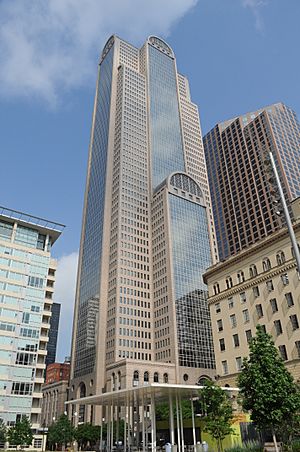
In the beginning, Dallas's economy relied on farming and trade. A big change happened in 1873 when many rail lines were built through the city. This helped Dallas grow a lot. By 1900, Dallas was the biggest inland market for cotton in the world.
In the 1930s, oil was found east of Dallas. This made Dallas a key center for the nation's oil market. After World War II, Dallas became a hub for technology companies. Today, it's sometimes called "Silicon Prairie" because so many telecommunications companies are here. Companies like Texas Instruments (which makes computer chips) have their headquarters in Dallas.
In the 1980s, Dallas had a building boom with lots of new homes and offices. After a slow period, central Dallas has been growing again since the early 2000s. Old buildings are being turned into homes and hotels, and new towers are being built. Klyde Warren Park helped connect different parts of downtown, making the area even more popular for new development.
The housing market in Dallas and the wider metro area is very strong. There's a lot of demand for homes and apartments. Even when oil prices dropped, Dallas's economy kept growing because it's so diverse. Many big companies have moved their main offices to the Dallas area, like Toyota and Jacobs Engineering.
The Dallas–Fort Worth area has one of the largest numbers of company headquarters in the United States. In 2022, Dallas itself had 11 Fortune 500 companies. The whole DFW region had 23, making it the fourth-largest concentration in the U.S. AT&T, one of the world's largest telecommunications companies, moved its headquarters to Downtown Dallas. Other big companies here include Southwest Airlines and Texas Instruments.
Dallas also has more shopping centers per person than any other U.S. city. Highland Park Village, which opened in 1931, was the second shopping center ever built in the U.S. Other major malls like the Dallas Galleria and NorthPark Center attract many visitors with their high-end stores.
Dallas is a very popular place for business travel. The Kay Bailey Hutchison Convention Center is one of the largest and busiest in the country.
Arts and Culture in Dallas
Dallas has a lively arts and culture scene with many museums, theaters, and music venues.
Arts and Museums in Dallas
The Arts District in Downtown Dallas is a special area with many places for art. It's the largest arts district in the United States! Here you can find the Dallas Museum of Art, the Morton H. Meyerson Symphony Center (home to the Dallas Symphony Orchestra), and the Nasher Sculpture Center.
The Perot Museum of Nature and Science in Downtown Dallas is a fantastic place to learn about nature and science. It's a huge building with six floors and many exciting exhibits.
The AT&T Dallas Center for the Performing Arts has several venues. These include the Moody Performance Hall, the Dee and Charles Wyly Theatre (home to the Dallas Theater Center), and the Winspear Opera House (home to the Dallas Opera).
Near Southern Methodist University is the Meadows Museum. It has a great collection of Spanish art. The Institute for Creation Research also has a museum in Dallas.
The former Texas School Book Depository is now the Sixth Floor Museum. It tells the story of President John F. Kennedy's assassination in 1963.
Deep Ellum, just east of Downtown, was famous for jazz and blues music in the 1920s and 1930s. Famous musicians like Blind Lemon Jefferson played here. Today, Deep Ellum is full of artists, bars, and concert venues. You'll also see lots of graffiti murals on walls and tunnels, making it a very colorful place.
The Cedars neighborhood, south of Downtown, is also becoming a popular spot for artists and entertainment. The Bishop Arts District in Oak Cliff is another area with many artists, unique restaurants, and shops.
The city of Dallas has an Office of Cultural Affairs. This office helps fund local artists and theaters, creates public art projects, and runs the city's classical radio station, WRR.
Dallas Libraries
The Dallas Public Library system serves the city. It started in 1901 with help from a grant by Andrew Carnegie. Today, the library has 30 branches across the city, including the large 8-story J. Erik Jonsson Central Library in Downtown.
Fun Places to Visit in Dallas
- Adolphus Hotel
- African American Museum
- American Airlines Center
- Arts District
- AT&T Performing Arts Center
- Bishop Arts District
- Cedars
- Cotton Bowl
- Dallas Arboretum and Botanical Garden
- Dallas Baptist University
- Dallas Chamber Symphony
- Dallas Hilton, the world's first modern Hilton
- Dallas Holocaust Museum/Center for Education & Tolerance
- Dallas Municipal Building
- Dallas Museum of Art
- Dallas World Aquarium
- Dallas Zoo
- Dealey Plaza
- Dee and Charles Wyly Theatre
- Design District
- Exposition Park, Dallas
- Fair Park
- Farmers Market
- Federal Reserve Bank of Dallas
- Frontiers of Flight Museum
- Galleria Dallas
- George W. Bush Presidential Center
- Highland Park Village
- John Fitzgerald Kennedy Memorial
- Kalita Humphreys Theater, designed by Frank Lloyd Wright
- Katy Trail
- Klyde Warren Park
- Majestic Theatre
- Margaret Hunt Hill Bridge
- Meadows Museum
- Morton H. Meyerson Symphony Center
- Munger Place Historic District
- Museum of Biblical Art
- The Nasher Sculpture Center
- Neiman Marcus Building
- NorthPark Center
- Pioneer Plaza
- Perot Museum of Nature and Science
- Reunion Tower
- Ronald Kirk Bridge
- Sixth Floor Museum at Dealey Plaza
- South Boulevard-Park Row Historic District
- Southern Methodist University
- Southfork Ranch as seen on Dallas (1978) and Dallas (2012)
- Swiss Avenue historical district
- Texas School Book Depository
- Texas Theatre
- Thanks-Giving Square
- Trammell & Margaret Crow Collection of Asian Art
- Trinity River Audubon Center
- Two Bit Circus
- Victory Park
- White Rock Lake
- House of Blues
Dallas Cuisine
Dallas is famous for its delicious barbecue, real Mexican food, and Tex-Mex cuisine. A fun fact: the Frozen margarita machine was invented by a Dallas restaurateur in 1971!
Events in Dallas

The State Fair of Texas has been held every year at Fair Park since 1886. It brings in about $50 million for the city each year! The Red River Shootout, a college football game between the University of Texas at Austin and the University of Oklahoma, also brings big crowds to the Cotton Bowl.
Other fun events include Cinco de Mayo celebrations, a Saint Patrick's Day parade, Juneteenth festivities, Taste of Dallas, the Deep Ellum Arts Festival, and the Greek Food Festival. For New Year's Eve, there's a big fireworks show at Reunion Tower.
Dallas Sports Teams
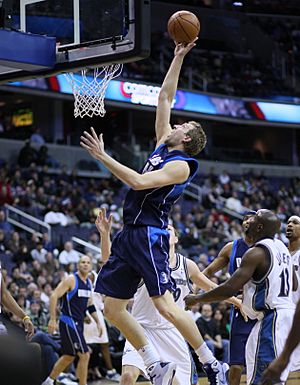
Dallas is home to two major league sports teams that play at the American Airlines Center:
- The Dallas Mavericks (NBA basketball team) won the NBA Championship in 2011.
- The Dallas Stars (NHL hockey team) won the Stanley Cup in 1999.
Nearby Arlington is home to:
- The Dallas Cowboys (NFL football team) play at AT&T Stadium and have won five Super Bowls.
- The Texas Rangers (MLB baseball team) play at Globe Life Field and won the World Series in 2023.
- The Dallas Wings (WNBA basketball team) play at College Park Center.
The MLS soccer team FC Dallas plays at Toyota Stadium in Frisco. They won the Lamar Hunt U.S. Open Cup in 1997 and 2016. There are also many minor league and college sports teams in the area.
The Cowboys are one of the most valuable sports teams in the world! Their stadium in Arlington hosted Super Bowl XLV and will host many matches for the 2026 FIFA World Cup.
The Texas Rangers won the American League championship three times and the World Series in 2023. The Dallas Mavericks won their first NBA championship in 2011, led by Dirk Nowitzki. The Dallas Stars won the Stanley Cup in the 1998–99 season.
Parks and Recreation in Dallas

Dallas has over 400 parks covering 21,000 acres (85 square kilometers) of parkland. The city's parks have 17 lakes, including White Rock and Bachman lakes. There are also over 60 miles (98 kilometers) of biking and jogging trails, like the Katy Trail. You can find recreation centers, sports fields, swimming pools, playgrounds, and golf courses throughout the city.
Fair Park in Dallas
Dallas's most famous park is Fair Park. It was built in 1936 for the Texas Centennial Exposition. Fair Park has the world's largest collection of Art Deco buildings and art. It's also home to the State Fair of Texas, which is the biggest state fair in the United States.
Klyde Warren Park in Dallas
Klyde Warren Park is a special park built over the Woodall Rodgers Freeway. It connects the Uptown and Downtown areas. The park has an amphitheater, jogging trails, a children's park, a dog park, and even an outdoor library. You can find food trucks and restaurants there, too. The park hosts weekly events like yoga and Zumba.
Turtle Creek Parkway Park

Built in 1913, Turtle Creek Parkway park is a long park along Turtle Creek. Native Americans used to live here because of the trees and natural spring water. The park is across from the Kalita Humphreys Theater, which was designed by Frank Lloyd Wright.
Lake Cliff Park
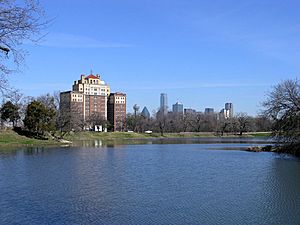
Lake Cliff Park opened in 1906 and was called "the Southwest's Greatest Playground." It used to have an amusement park, a huge pool, and three theaters.
Reverchon Park
Reverchon Park was bought by Dallas in 1935. It was meant to be a crown jewel of the park system. It has picnic areas, a baseball field, and tennis courts. The park was named after Julien Reverchon, a botanist who lived in an old colony in West Dallas.
Trinity River Project

As part of the Trinity River Project, the Great Trinity Forest is a huge 6,000-acre (24 square kilometer) urban forest. It's the largest urban hardwood forest in the United States! The Trinity River Audubon Center opened in 2008 and is a great place to explore trails and watch nature.
Katy Trail
The Katy Trail is a popular trail built on an old railroad line. It's 3.5 miles (5.6 kilometers) long and goes through neighborhoods like Turtle Creek and Knox Park. It's a great place for walking, jogging, and biking.
Nature Preserves
Dallas has three nature preserves that are part of the larger Dallas County Preserve System. These include the Joppa Preserve, the McCommas Bluff Preserve, and the Cedar Ridge Preserve. The Cedar Ridge Preserve is a 633-acre (2.5 square kilometer) natural park with hiking trails and picnic areas.
Dallas Zoo
The city is also home to Texas's first and largest zoo, the Dallas Zoo. It covers 106 acres (0.4 square kilometers) and opened in its current spot in 1888.
Education in Dallas
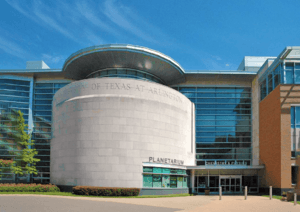
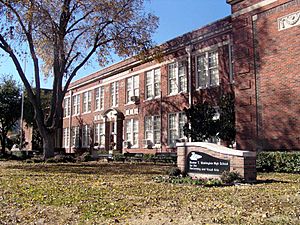
Dallas has many schools, colleges, and universities. There are 337 public schools, 89 private schools, 38 colleges, and 32 libraries. The Dallas–Fort Worth area has also been home to six Nobel Prize winners!
Colleges and Universities in Dallas
The Dallas area has a large number of colleges and universities.
Universities within Dallas City Limits
- UT Southwestern Medical Center ("UTSW") is a famous medical school north of downtown Dallas. Many Nobel Prize winners have taught here.
- Texas Woman's University has a nursing school in Dallas.
- Paul Quinn College is a private college in southeast Dallas that has a special history for Black students.
- The University of North Texas at Dallas is the first public university within Dallas city limits.
- Dallas Baptist University is a private university in southwest Dallas. It has over 5,600 students and offers many degrees.
- Dallas Theological Seminary is a leading seminary for evangelical Christians.
- Criswell College is also a Christian college near Dallas Theological Seminary.
- Dallas College (formerly Dallas County Community College District) has seven campuses around the area, offering two-year degrees.
Universities within Dallas County
- Southern Methodist University is a private university in University Park, a town surrounded by Dallas.
- The University of Texas at Dallas is in Richardson, north of Downtown. It's a top research university.
- The University of Dallas, in Irving, is a Catholic university.
Other Nearby Colleges and Universities
- The University of Texas at Arlington
- The University of North Texas in Denton
- Texas Woman's University in Denton
- Texas Christian University in Fort Worth
- Texas Wesleyan University in Fort Worth
Primary and Secondary Schools in Dallas
Most students in Dallas go to schools in the Dallas Independent School District (DISD). It's the second-largest school district in Texas. One of its special schools, the School for the Talented and Gifted, is very highly rated. Some parts of Dallas are also in other school districts like Carrollton-Farmers Branch and Richardson.
Private Schools in Dallas
Many students in Dallas attend private schools. Some of these include:
- Alcuin School
- Bishop Dunne Catholic School
- Bishop Lynch High School
- Episcopal School of Dallas
- The Hockaday School
- Jesuit College Preparatory School of Dallas
- St. Mark's School of Texas
- Ursuline Academy of Dallas
Media in Dallas
Dallas has many local newspapers, magazines, TV stations, and radio stations. The main daily newspaper is The Dallas Morning News, which started in 1885. There are also Spanish-language newspapers like Al Día and ethnic newspapers in Chinese, Korean, and Vietnamese.
Other publications include the Dallas Weekly and the Dallas Observer. D Magazine is a popular monthly magazine about life and business in Dallas.
Dallas has many TV stations, including those for Fox, NBC, ABC, CBS, and PBS. Over 100 radio stations operate in the Dallas area. The city of Dallas even runs its own classical music station, WRR 101.1 FM. It's the oldest commercially operated radio station in Texas!
Transportation in Dallas

Most people in Dallas use cars to get around. However, the city is working to add more ways to travel, like light rail, biking paths, and buses. Dallas was ranked the 23rd most walkable big city in the U.S. in 2011.
Highways in Dallas
Dallas is a major crossroads for four big interstate highways: I-20, I-30, I-35E, and I-45. The freeway system looks like a wagon wheel. There's a small loop around Downtown, then the I-635 loop further out. Even further out is the President George Bush Turnpike, which is a toll road.
The "spokes" of the wheel are highways that go out from Downtown, like I-30, I-35E, and I-45, plus US 75 and others. A famous interchange is the High Five Interchange, where I-635 and US 75 meet. It has five levels and is one of the largest freeway interchanges in the U.S.
Airports in Dallas
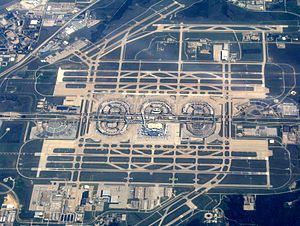
Dallas has two main commercial airports: Dallas Fort Worth International Airport (DFW) and Dallas Love Field. DFW is huge, bigger than the island of Manhattan! It's the busiest airport in Texas and one of the busiest in the world. American Airlines has its headquarters near DFW. Dallas Love Field is closer to Downtown and is home to Southwest Airlines.
Public Transportation in Dallas
Dallas Area Rapid Transit (DART) is the public transportation system. It has trains and buses. DART started the first light rail system in Texas in 1996. Now, it's the largest light rail system in the U.S. with over 55 stations and 72 miles of track. It has four light rail lines and a commuter train line.
The DART Orange Line even goes to DFW Airport, connecting to DFW Skylink to help passengers get to their terminals easily. There's also a trolley project in Dallas that links Downtown to Oak Cliff and the Bishop Arts District.
Amtrak trains also stop at Union Station, offering service to cities like Chicago and Los Angeles.
Notable People from Dallas
Dallas's International Connections
Dallas works to build relationships with cities around the world. These "Sister City" and "Friendship City" programs help create understanding and boost business between Dallas and other countries.
Dallas Sister Cities
Dallas has these sister cities:
Dallas Friendship Cities
Dallas has friendly relations with:
See also
 In Spanish: Dallas para niños
In Spanish: Dallas para niños


